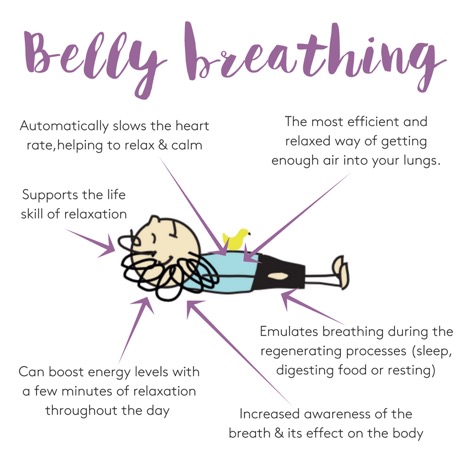Diaphragmatic breathing, sometimes called abdominal or belly breathing, is a deep breathing technique that engages your diaphragm, which is the large, dome-shaped muscle that runs horizontally across your abdomen, under your ribcage.
Our natural breathing patterns should engage our diaphragm, but many people actually don’t breathe properly. When you breathe in, your belly should expand. When you breathe out, your belly should contract, or move inward.
Belly breathing has been shown to be highly effective both as a calming strategy and for a variety of health reasons. Breathing is one of the most sensitive indicators or warning signs of stress, because it is such a vital link between our minds and bodies. By increasing our awareness about breathing and by practicing breathing exercises, it is possible to decrease our levels of stress, and help us to feel more relaxed and calm.
Having sufficient breath support and coordination is also important for speech purposes. Insufficient or disrupted breathing can negatively impact your child’s ability to speak fluently or use their voice correctly. Teaching children visual breathing exercises can help them learn to use breath effectively.
For children with voice disorders and/or vocal nodules, using diaphragmatic breathing gives their voice more support, and allows them to speak with less effort and strain on the vocal cords or surrounding muscles. Learning to regulate breathing can help a child who stutters to develop a breathing pattern that helps them to relax the body and mind, relieve chronic tension, and achieve more fluent speech.
Here are some ways to teach belly breathing to your child:
- Ask your child to lie on his back, close his eyes and breathe normally while paying attention to all the parts of his body that move when he breathes.
- Ask him to place one hand on his upper chest and the other on his stomach.
- Tell your child to inhale through the nose and into his stomach. The hand on his belly should move upwards and the one on his chest should remain still.
- Tell him to inhale for a count of four, then hold it in for a count of four.
- Ask your child to exhale. Tell him to push out the air from his stomach. The hand placed on his stomach will move downwards.
- Repeat the exercise for five to 10 minutes or until your child feels relaxed.
- You can have your child put a stuffed animal on their belly while they breathe in to move the stuffed animal up, then breathe out and bring the stuffed animal back down.
- https://www.parent.com/3-breathing-exercises-to-calm-kids-of-all-ages/
https://www.verywellhealth.com/how-to-breathe-with-your-belly-89853
https://www.parent.com/3-breathing-exercised-to-calm-kids-of-all-ages/
Image Credit: https://childreninspiredbyyoga.com

Get a Free Online Assessment
Looking for an expert opinion on your child's needs? Fill out a 3 minute questionnaire and receive a personal evaluation from our staff
By submitting this form, you are consenting to receive marketing emails from: . You can revoke your consent to receive emails at any time by using the SafeUnsubscribe® link, found at the bottom of every email. Emails are serviced by Constant Contact




